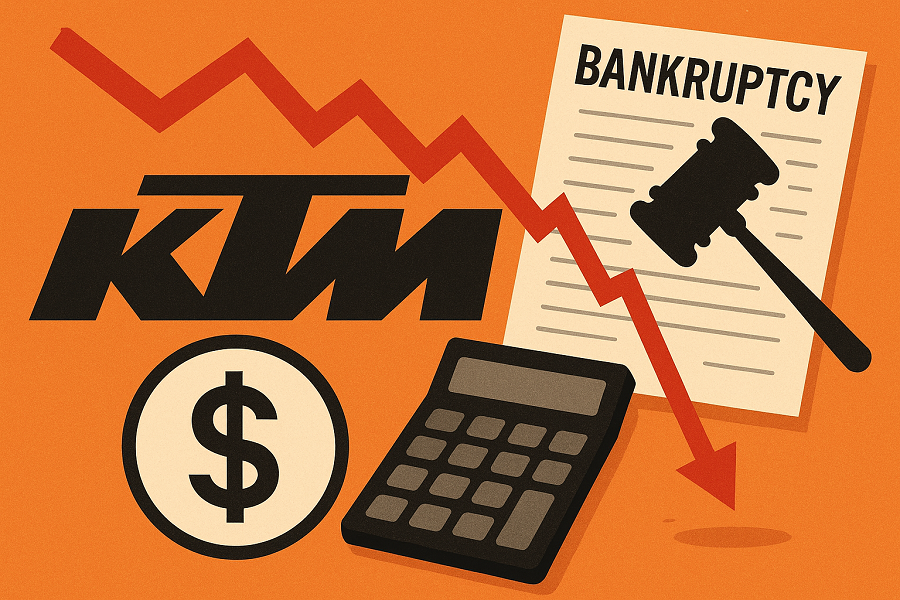Table of Content
Table of Contents
Introduction – KTM Bankruptcy
KTM, the iconic Austrian motorcycle manufacturer known for its bold performance bikes, found itself teetering on the edge of bankruptcy in late 2024. With nearly €2.9 billion in debt and warehouses packed with unsold motorcycles, the company entered self-administration—a structured form of insolvency. Headlines like “KTM Bankruptcy” and “KTM Restructuring” dominated the industry. But this wasn’t just a typical financial hiccup—it was a wake-up call for the entire powersports world. As KTM’s future hung in the balance, major players like Bajaj Auto stepped in, signaling a dramatic turn of events that would reshape the brand forever.
What Triggered KTM’s Bankruptcy Filing?
KTM’s downfall wasn’t sudden—it was a storm brewing for months. Here’s what went wrong:
- Sales dropped drastically in late 2023 and 2024.
- Production continued at high levels, leading to over 300,000 unsold bikes.
- Poor inventory management overwhelmed warehouses.
- Global demand shifted post-pandemic, hurting performance.
- Cash flow issues snowballed into a €2.9 billion debt crisis.
By November 29, 2024, KTM filed for self-administration in Austria—a legal step toward bankruptcy protection.
Timeline: KTM’s Collapse to Recovery
| Date | Event |
|---|---|
| Nov 29, 2024 | KTM files for self-administration (bankruptcy protection) |
| Jan 2025 | Stefan Pierer resigns as CEO of Pierer Mobility |
| Feb 25, 2025 | Creditors approve restructuring plan (30% repayment deal) |
| Mar 2025 | Production temporarily resumes to manage stock |
| May 23, 2025 | Creditors receive €548M (30% of total owed) |
| July 2025 (planned) | Full production restart expected after inventory reset |
This timeline marks the crucial steps KTM took to avoid a full-blown collapse.
Who Saved KTM? The Role of Bajaj Auto
Bajaj Auto, India’s major motorcycle player and a long-time ktm bankruptcy filing update stakeholder, emerged as the savior.
- €200 million injected immediately to support operations.
- Committed to €800 million total investment to stabilize KTM.
- Could eventually gain majority control of KTM.
Bajaj’s involvement shifted KTM’s fate from bankruptcy to a possible revival.

Creditors, Hedge Funds & Legal Tensions
Not all creditors were thrilled with the restructuring offer. Here’s what happened:
- KTM’s 30% repayment offer was controversial.
- Whitebox hedge fund challenged the plan, seeking better terms.
- Austrian insolvency laws allowed KTM to proceed with creditor approval.
Despite opposition, the plan was approved on February 25, 2025, securing KTM’s short-term future.
MotoGP and Brand Continuity
KTM’s racing fans had one burning question: Will the KTM MotoGP team survive?
✅ The answer is yes—for now.
- KTM’s MotoGP program is confirmed through 2025.
- Red Bull remains a key sponsor.
- Brad Binder and rising star Pedro Acosta stay onboard.
- Satellite team Tech3 also continues racing.
This helped maintain the brand’s global presence even amid financial chaos.
KTM’s Global Production Shutdown
KTM halted its global production in late 2024 to manage inventory. Key points:
- Nearly 130,000–300,000 bikes sat unsold in warehouses.
- Manufacturing stopped in Austria and other facilities.
- March 2025 saw partial production restart.
- Full production expected by July 2025, pending financial stability.
Layoffs, Workforce Cuts & Dealer Impact
The bankruptcy filing hit KTM’s workforce and dealer network hard:
Job Losses:
- ~200 staff laid off initially in Austria.
- Potential impact on 2,380–3,600 employees worldwide.
Dealers Faced:
- Delays in new deliveries.
- Uncertainty around spare parts and service.
- Loss in consumer confidence.
Stefan Pierer: From CEO to Exit
Stefan Pierer, long-time CEO of Pierer Mobility, stepped down in January 2025, after leading KTM for decades.
- His leadership brought KTM to global fame.
- However, critics point to expansion risks and overproduction.
- The exit marks a new chapter for KTM, possibly under Bajaj-led leadership.
How KTM’s Collapse Affects the Motorcycle Market
The ktm bankruptcy news crisis didn’t happen in isolation. It sent shockwaves across the powersports industry:
- Rivals like BMW Motorrad and Yamaha are eyeing KTM’s lost market share.
- Brands like CFMoto, who partner with KTM, may pivot their strategies.
- KTM’s issues raised concerns about overproduction trends in the motorcycle market.
Consumer Trust & Community Reaction
KTM owners and fans took to forums and social media:
- Concerns over parts availability, bike warranties, and resale value.
- Some dealers reassured customers, while others stayed silent.
- Enthusiasts are hopeful, but cautious about KTM’s future.

What’s Next? Recovery Scenarios
KTM’s future depends on key milestones:
- Final court approval of the plan (expected June 2025).
- Production ramp-up by July 2025.
- Bajaj investment completion over the next few months.
- Possible involvement of new investors (e.g., CFMoto, BMW rumors).
KTM isn’t fully in the clear—but it’s on a narrow path to survival.
Conclusion: Will KTM Rise Again?
KTM’s near-bankruptcy shook the motorcycle world—but it also revealed its resilience. With Bajaj’s backing, a firm restructuring plan, and continued MotoGP presence, KTM has a fighting chance. However, its long-term survival depends on executing recovery plans, rebuilding consumer trust, and managing future risks better. For now, ktm bankruptcy update avoids bankruptcy—but the ride ahead is far from smooth.


